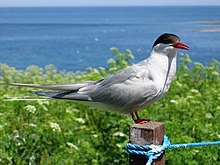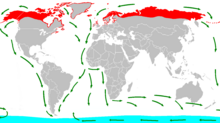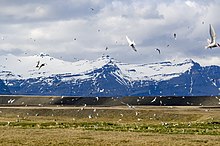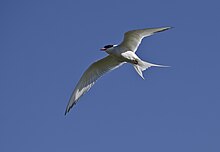Arctic tern
| Arctic tern | |
|---|---|

| |
| Farne Islands | |
| Scientific classification | |
| Domain: | Eukaryota |
| Kingdom: | Animalia |
| Phylum: | Chordata |
| Class: | Aves |
| Order: | Charadriiformes |
| Family: | Laridae |
| Genus: | Sterna |
| Species: | S. paradisaea
|
| Binomial name | |
| Sterna paradisaea Pontoppidan,1763[2]
| |

| |
| Range ofS. paradisaea Breeding grounds wintering grounds migration routes | |
| Synonyms | |
|
Sterna portlandica | |
TheArctic tern(Sterna paradisaea) is aternin thefamilyLaridae.Thisbirdhas acircumpolarbreeding distribution covering theArcticand sub-Arctic regions of Europe (as far south asBrittany), Asia, and North America (as far south asMassachusetts). Thespeciesis stronglymigratory,seeing two summers each year as it migrates along a convoluted route from its northern breeding grounds to theAntarcticcoast for the southern summer and back again about six months later. Recent studies have shown average annual round-trip lengths of about 70,900 km (44,100 mi) for birds nesting inIcelandandGreenlandand about 48,700 km (30,300 mi) for birds nesting in theNetherlands.These are by far the longest migrations known in the animal kingdom. The Arctic tern nests once every one to three years (depending on its mating cycle).
Arctic terns are medium-sized birds. They have a length of 28–39 cm (11–15 in) and awingspanof 65–75 cm (26–30 in).[3]They are mainly grey and white plumaged, with a red/orange beak and feet, white forehead, a black nape and crown (streaked white), and white cheeks. The grey mantle is 305 mm (12.0 in), and the scapulae are fringed brown, some tipped white. The upper wing is grey with a white leading edge, and the collar is completely white, as is the rump. The deeply forked tail is whitish, with grey outer webs.
Arctic terns are long-lived birds, with many reaching fifteen to thirty years of age. They eat mainly fish and small marineinvertebrates.The species is abundant, with an estimated two million individuals. While the trend in the number of individuals in the species as a whole is not known, exploitation in the past has reduced this bird's numbers in the southern reaches of its ranges.
Etymology
[edit]The genus nameSternais derived fromOld English"stearn", "tern".[4]The specificparadisaeais fromLate Latinparadisus,"paradise".[5] TheScotsnamespictarnie,[6]tarrock[7]and their many variants are also believed to beonomatopoeic,derived from the distinctive call.[8]Due to the difficulty in distinguishing the two species, all the informal common names are shared with thecommon tern.[9]
Distribution and migration
[edit]The Arctic tern has a continuous worldwide circumpolar breeding distribution; there are no recognizedsubspecies.It can be found in coastal regions in cooler temperate parts ofNorth AmericaandEurasiaduring thenorthernsummer. During thesouthernsummer, it can be found at sea, reaching the northern edge of the Antarctic ice.[10]
The Arctic tern is famous for its migration; it flies from its Arctic breeding grounds to the Antarctic and back again each year. The shortest distance between these areas is 19,000 km (12,000 mi). The long journey ensures that this bird sees two summers per year and more daylight than any other creature on the planet.[11]One example of this bird's remarkable long-distance flying abilities involves an Arctic ternringedas an unfledged chick on theFarne Islands,Northumberland,UK, in the northern summer of 1982 that reachedMelbourne,Australia in October, just three months after fledging – a journey of more than 22,000 km (14,000 mi).[12]Another example is that of a chick ringed inLabrador,Canada,on 23 July 1928. It was found in South Africa four months later.[13]
A 2010 study using tracking devices attached to the birds showed that the above examples are not unusual for the species. In fact, the study showed that previous research had seriously underestimated the annual distances travelled by the Arctic tern. Eleven birds that bred in Greenland or Iceland covered 70,900 km (44,100 mi) on average in a year, with a maximum of 81,600 km (50,700 mi).[14]The difference from previous estimates is due to the birds taking meandering courses rather than following a straight route as was previously assumed. The birds follow a somewhat convoluted course in order to take advantage of prevailing winds.[15]The average Arctic tern lives about 30 years and will, based on the above research, travel some 2.4 million km (1.5 million mi) during its lifetime, the equivalent of a roundtrip from Earth to the Moon more than three times.[16]
A 2013 tracking study of half a dozen Arctic terns breeding in theNetherlands[17]shows average annual migrations of c. 48,700 km (30,300 mi). On their way south, these birds roughly followed the coastlines ofEuropeandAfrica.[18]
Arctic terns usually migrate sufficiently far offshore that they are rarely seen from land outside the breeding season.[19]
Description and taxonomy
[edit]
The Arctic tern is a medium-sized bird around 33–36 cm (13–14 in) from the tip of its beak to the tip of its tail. The wingspan is 76–85 cm (30–33 in).[19]The weight is 86–127 g (3.0–4.5 oz). Thebeakis dark red, as are the short legs and webbed feet. Like most terns, the Arctic tern hashigh aspect ratio wingsand a tail with a deep fork.[19]
The adultplumageis grey above, with a black nape and crown and white cheeks. The upperwings are pale grey, with the area near the wingtip being translucent. The tail is white, and the underparts pale grey. Both sexes are similar in appearance. The winter plumage is similar, but the crown is whiter and the bills are darker.[19]
Juveniles differ from adults in their black bill and legs, "scaly" appearing wings, and mantle with dark feather tips, dark carpal wing bar, and short tail streamers.[19]During their first summer, juveniles also have a whiter forecrown.[20]
The species has a variety ofcalls;the two most common being thealarm call,made when possible predators (such as humans or othermammals) enter the colonies, and theadvertising call.[21]
While the Arctic tern is similar to thecommonandroseate terns,its colouring, profile, and call are slightly different. Compared to the common tern, it has a longer tail and mono-coloured bill, while the main differences from the roseate are its slightly darker colour and longer wings. The Arctic tern's call is more nasal and rasping than that of the common, and is easily distinguishable from that of the roseate.[22]
This bird's closest relatives are a group of South Polar species, theSouth American(Sterna hirundinacea),Kerguelen(S. virgata), andAntarctic(S. vittata) terns.[23]
The immature plumages of Arctic tern were originally described as separate species,Sterna portlandicaandSterna pikei.[24]
Reproduction
[edit]

Breeding begins around the third or fourth year.[25]Arctic terns mate for life and, in most cases, return to the same colony each year.[26]Courtshipis elaborate, especially in birds nesting for the first time.[27]Courtship begins with a so-called "high flight", where a female will chase the male to a high altitude and then slowly descend. This display is followed by "fish flights", where the male will offer fish to the female. Courtship on the ground involves strutting with a raised tail and lowered wings. After this, both birds will usually fly and circle each other.[27]
Both sexes agree on a site for a nest, and both will defend the site. During this time, the male continues to feed the female. Mating occurs shortly after this.[27]Breeding takes place incolonieson coasts, islands and occasionally inland ontundranear water. It often forms mixed flocks with thecommon tern.It lays from one to threeeggsper clutch, most often two.[19]
It is one of the most aggressive terns, fiercely defensive of its nest and young. It will attack humans and large predators, usually striking the top or back of the head. Although it is too small to cause serious injury to an animal of a human's size, it is still capable of drawing blood, and is capable of repelling many raptorial birds, polar bears[28]and smaller mammalian predators such as foxes and cats.[11]
The nest is usually a depression in the ground, which may or may not be lined with bits of grass or similar materials. The eggs are mottled and camouflaged.[19]Both sexes share incubation duties. The young hatch after 22–27 days andfledgeafter 21–24 days.[19]If the parents are disturbed and flush from the nest frequently the incubation period could be extended to as long as 34 days.[21]
When hatched, the chicks aredowny.Beingprecocial,the chicks begin to move around and explore their surroundings within one to three days after hatching.[29]Usually they do not stray far from the nest. Chicks are brooded by the adults for the first ten days after hatching.[30]Both parents care for hatchlings.[19]Chick diets always include fish, and parents selectively bring larger prey items to chicks than they eat themselves.[21]Males bring more food than females. Feeding by the parents lasts for roughly a month before being weaned off slowly.[19]After fledging, the juveniles learn to feed themselves, including the difficult method of plunge-diving.[31]They will fly south to winter with the help of their parents.[32]
Arctic terns are long-lived birds that spend considerable time raising only a few young, and are thus said to beK-selected.[33]A 1957 study in theFarne Islandsestimated an annual survival rate of 82%.[34]
Ecology and behaviour
[edit]
The diet of the Arctic tern varies depending on location and time, but is usuallycarnivorous.In most cases, it eats smallfishor marinecrustaceans.[10][19]Fish species comprise the most important part of the diet, and account for more of thebiomassconsumed than any other food. Prey species are immature (1–2-year-old) shoaling species such asherring,cod,sandlances,andcapelin.[11]Among the marine crustaceans eaten areamphipods,crabsandkrill.Sometimes, these birds also eatmolluscs,marine worms, orberries,and on their northern breeding grounds,insects.[29]
Arctic terns sometimes dip down to the surface of the water to catch prey close to the surface. They may also chase insects in the air when breeding.[29]It is also thought that Arctic terns may, in spite of their small size, occasionally engage inkleptoparasitismby swooping at birds so as to startle them into releasing their catches.[29]Several species are targeted—conspecifics, other terns (like the common tern), and someaukandgrebespecies.[21]
While nesting, Arctic terns are vulnerable to predation by cats and other animals.[10]Besides being a competitor for nesting sites, the largerherring gullsteals eggs and hatchlings. Camouflaged eggs help prevent this, as do isolated nesting sites.[31]Scientists have experimented with bamboo canes erected around tern nests. Although they found fewer predation attempts in the caned areas than in the control areas, canes did not reduce the probability of predation success per attempt.[35]While feeding,skuas,gulls, and other tern species will often harass the birds and steal their food.[36]
Conservation status
[edit]The total population for the arctic tern is estimated at more than two million individuals, with more than half of the population in Europe. The breeding range is very large, and although the population is considered to be decreasing, this species is evaluated as aspecies of least concernby theIUCN.[1] Arctic terns are among the species to which theAgreement on the Conservation of African-Eurasian Migratory Waterbirdsapplies.[37]
The population inNew Englandwas reduced in the late nineteenth-century because of hunting for the millinery trade.[21]Exploitation continues in westernGreenland,where the population of the species has been reduced greatly since 1950.[38]In Iceland, the Arctic tern has been regionally uplisted to Vulnerable as of 2018, due to the crash ofsandeel(Ammodytesspp.) stocks.[39]
At the southern part of their range, the Arctic tern has been reducing in numbers. Much of this is due to a lack of food.[20]However, most of these birds' range is extremely remote, with no apparent trend in the species as a whole.[29]The Arctic terns' dispersal pattern is affected by changing climatic conditions,[40]and its ability to feed in its Antarctic wintering is dependent on sea-ice cover, but unlike breeding species, it is able to move to a different area if necessary, and can be used as a control to investigate the effect ofclimate changeon breeding species.[41]
Cultural depictions
[edit]The Arctic tern has appeared on thepostage stampsof several countries and dependent territories. The territories includeÅland,Alderney,andFaroe Islands.Countries include Canada,Finland,Iceland,andCuba.[42]
The Arctic tern featured prominently in a sketch on the improv comedy television showWhose Line Is It Anyway?involvingColin MochrieandRyan Stiles.[43]
References
[edit]- ^abBirdLife International (2018)."Sterna paradisaea".IUCN Red List of Threatened Species.2018:e.T22694629A132065195.doi:10.2305/IUCN.UK.2018-2.RLTS.T22694629A132065195.en.Retrieved12 November2021.
- ^"Arctic Tern — BirdLife Species Factsheet".birdlife.org.BirdLife International.Retrieved17 August2006.
- ^"Arctic Tern".All About Birds.Cornell Lab of Ornithology.
- ^"Sterna".Oxford English Dictionary(Online ed.).Oxford University Press.(Subscription orparticipating institution membershiprequired.)
- ^Jobling, James A (2010).The Helm Dictionary of Scientific Bird Names.London: Christopher Helm. p.291.ISBN978-1-4081-2501-4.
- ^SND: PictarnieArchived30 May 2013 at theWayback Machine
- ^SND: tarrockArchived30 May 2013 at theWayback Machine
- ^Hume (1993) pp. 12–13.
- ^Cocker, Mark; Mabey, Richard (2005).Birds Britannica.London: Chatto & Windus. pp. 246–247.ISBN0-7011-6907-9.
- ^abc"Arctic tern".Royal Society for the Protection of Birds.Retrieved17 August2006.
- ^abcCramp, S., ed. (1985).Birds of the Western Palearctic.Oxford University Press. pp. 87–100.ISBN0-19-857507-6.
- ^Heavisides, A.; Hodgson, M.S.; Kerr, I. (1983).Birds in Northumbria 1982.Tyneside Bird Club.
- ^"Birds of Nova Scotia: Arctic Tern".Nova Scotia Museum of Natural History. Archived fromthe originalon 24 August 2006.Retrieved22 August2006.
- ^Egevang, Carsten; Stenhouse, Iain J.; Phillips, Richard A.; Petersen, Aevar; Fox, James W.; Silk, Janet R. D. (2010)."Tracking of Arctic ternsSterna paradisaeareveals longest animal migration ".Proceedings of the National Academy of Sciences.107(5): 2078–2081.Bibcode:2010PNAS..107.2078E.doi:10.1073/pnas.0909493107.PMC2836663.PMID20080662.
- ^"Arctic terns' flying feat".Reuters.11 January 2010.Retrieved20 January2010.
- ^Inman, Mason (12 January 2010)."World's Longest Migration Found--2X Longer Than Thought".National Geographic Society.Archived fromthe originalon 16 January 2010.Retrieved19 August2016.
- ^Fijn, R.C.; Hiemstra, D.; Phillips, R.A.; van der Winden, J. (2013)."Arctic TernsSterna paradisaeafrom the Netherlands migrate record distances across three oceans to Wilkes Land, East Antarctica ".Ardea.101:3–12.doi:10.5253/078.101.0102.S2CID84699518.
- ^"Dutch Arctic Terns migrating to Antarctica via Australia".BirdGuides.com.BirdGuides. 30 May 2013.
- ^abcdefghijkDel Hoyo, Josep; Elliott, Andrew; Sargatal, Jordi, eds. (1996).Handbook of the Birds of the World.Vol. 3. Barcelona: Lynx Edicions. p.653.ISBN84-87334-20-2.
- ^abHowell, Steve N.G.; Jaramillo, Alvaro (2006). Alderfer, Jonathan (ed.).National Geographic Complete Birds of North America.National Geographic Society. pp. 272–273.ISBN0-7922-4175-4.
- ^abcdeHatch, J.J. (2002). Poole, A.; Gill, F. (eds.).Arctic Tern (Sterna paradisaea).Philadelphia, PA.: The Birds of North America. p. 707.
- ^Olson, Klaus Malling; Larsson, Hans (1995).Terns of Europe and North America.Princeton University Press.ISBN0-7136-4056-1.
- ^Bridge, E.S.; Jones, A.W.; Baker, A.J. (2005)."A phylogenetic framework for the terns (Sternini) inferred from mtDNA sequences: implications for taxonomy and plumage evolution"(PDF).Molecular Phylogenetics and Evolution.35(2): 459–469.Bibcode:2005MolPE..35..459B.doi:10.1016/j.ympev.2004.12.010.PMID15804415.Archived fromthe original(PDF)on 20 July 2006.Retrieved7 September2006.
- ^Kaufman, Kenn(1990)."chapter 18".Peterson Field Guides: Advanced Birding.Houghton Mifflin. p.135.ISBN0-395-53517-4.
- ^Hawksley, Oscar (1957)."Ecology of a breeding population of Arctic Terns"(PDF).Bird-Banding.28(2): 57–92.doi:10.2307/4510623.JSTOR4510623.
- ^Perrins (2003),p. 267
- ^abcPerrins (2003),p. 268
- ^"Arctic Bird Attack - Nat Geo WILD".Archived fromthe originalon 27 November 2016.Retrieved26 November2016.
- ^abcdeKaufman, Kenn(1996).Lives of North American birds.Houghton Mifflin. p.260.ISBN0-395-77017-3.
- ^Klaassen, M.; Bech, C.; Masman, D.; Slagsvold, G. (1989)."Growth and energetics of Arctic tern chicks (Sterna paradisaea) "(PDF).Auk.106:240–248.Retrieved1 September2006.
- ^abPerrins (2003),p. 269
- ^National Audubon Society."Arctic Tern (Sterna paradisaea)".Archived fromthe originalon 15 June 2006.Retrieved1 September2006.
- ^Schreiber, Elizabeth A.; Burger, Joanne, eds. (2001).Biology of Marine Birds.Boca Raton:CRC Press.ISBN0-8493-9882-7.
- ^Cullen, J.M. (1957). "Plumage, age and mortality in the Arctic Tern".Bird Study.4(4): 197–207.Bibcode:1957BirdS...4..197C.doi:10.1080/00063655709475891.
- ^Boothby, Claire; Redfern, Chris; Schroeder, Julia (2019). "An evaluation of canes as a management technique to reduce predation by gulls of ground-nesting seabirds".Ibis.161(2): 453–458.doi:10.1111/ibi.12702.hdl:10044/1/66825.ISSN1474-919X.S2CID92479448.
- ^Perrins (2003),p. 271
- ^AEWA."African Eurasian Waterbird Agreement Annex II: Species list".Archived fromthe originalon 1 January 2006.Retrieved17 August2006.
- ^Hansen, K. (2001). "Threats to wildlife in Greenland".Seabird Group Newsletter.89:1–2.
- ^Skarphéðinsson, Kristinn Haukur (October 2018)."Kría (Sterna paradisaea)"[Arctic Tern] (in Icelandic). Icelandic Institute of Natural History. Archived fromthe originalon 22 April 2019.Retrieved22 April2019.
- ^Møller, A. P.; Flensted-Jensen, E.; Mardal, W. (2006)."Dispersal and climate change: a case study of the Arctic ternSterna paradisaea".Global Change Biology.12(10): 2005–2013.Bibcode:2006GCBio..12.2005M.doi:10.1111/j.1365-2486.2006.01216.x.ISSN1365-2486.S2CID73693946.
- ^Redfern, Chris P. F.; Bevan, Richard M. (2020)."Use of sea ice by Arctic ternsSterna paradisaeain Antarctica and impacts of climate change ".Journal of Avian Biology.51(2).doi:10.1111/jav.02318.S2CID209604345.
- ^Gibbons, Chris."Arctic Tern stamps".Archived from the original on 28 September 2006.Retrieved24 August2006.
{{cite web}}:CS1 maint: unfit URL (link) - ^Lasater, Hope (15 July 2021)."29" Whose Line Is It Anyway? "Moments That Are Funnier Than They Have Any Right To Be".BuzzFeed.Retrieved28 May2024.
Bibliography
[edit]- Perrins, Christopher,ed. (2003).Firefly Encyclopedia of Birds.Buffalo, N.Y.: Firefly Books.ISBN978-1-55297-777-4.OCLC51922852.
Further reading
[edit]- Harrison, Peter (2003).Seabirds of the World: A Photographic Guide.Princeton, N.J.:Princeton University Press.ISBN978-0-691-01551-4.OCLC487925419.
External links
[edit]- Arctic tern – Species text in The Atlas of Southern African Birds
- "Arctic tern media".Internet Bird Collection.
- Arctic tern imagesatARKive
- Arctic tern photo galleryat VIREO (Drexel University)
- Audio recordings of Arctic ternonXeno-canto.

